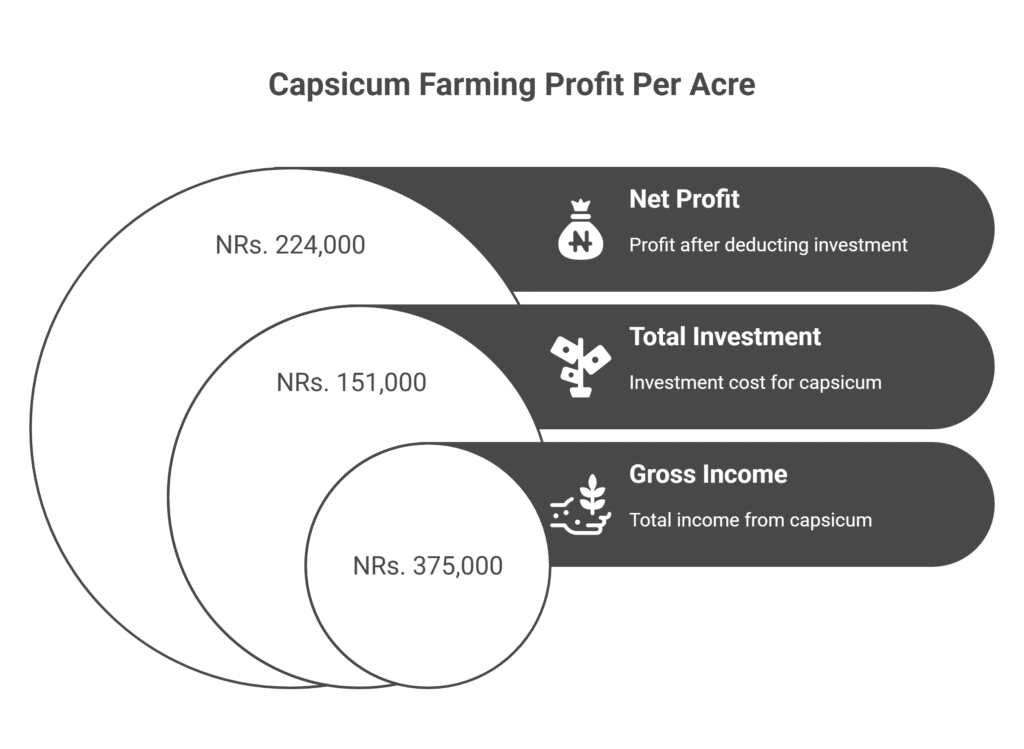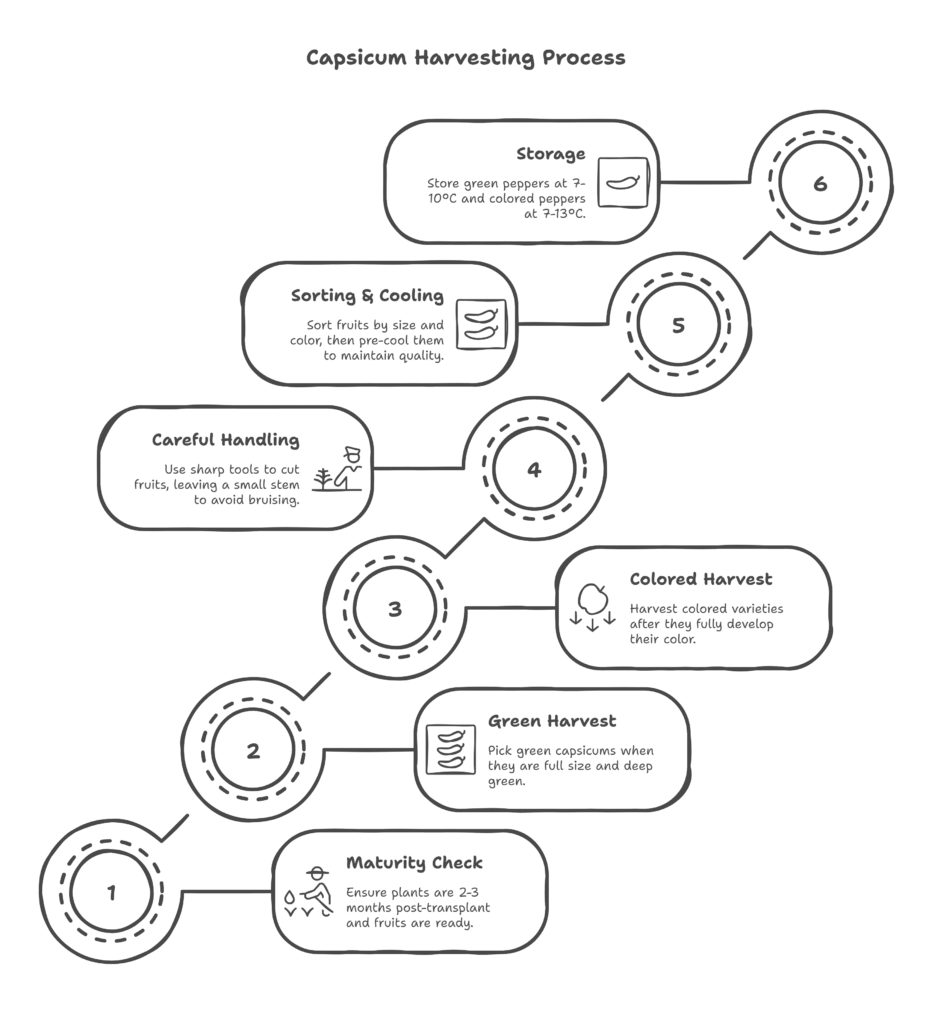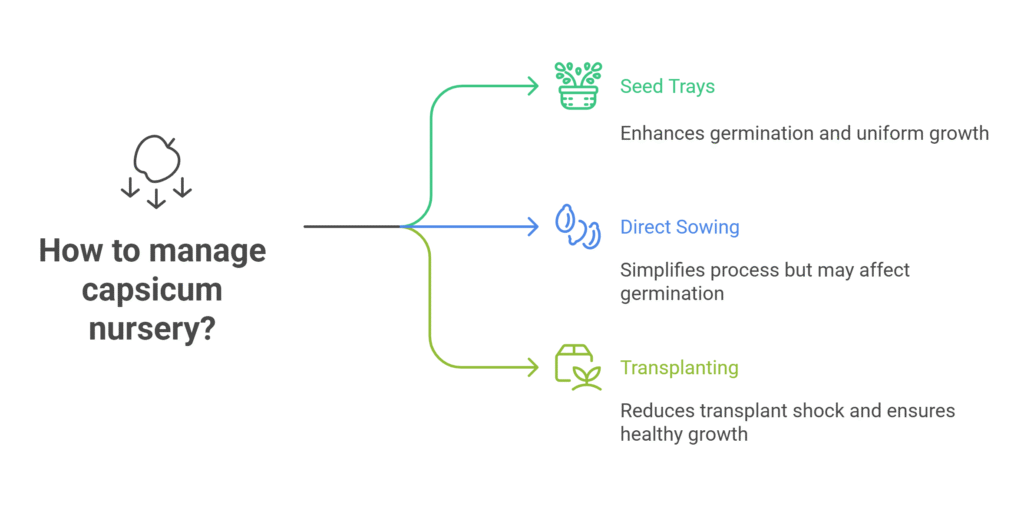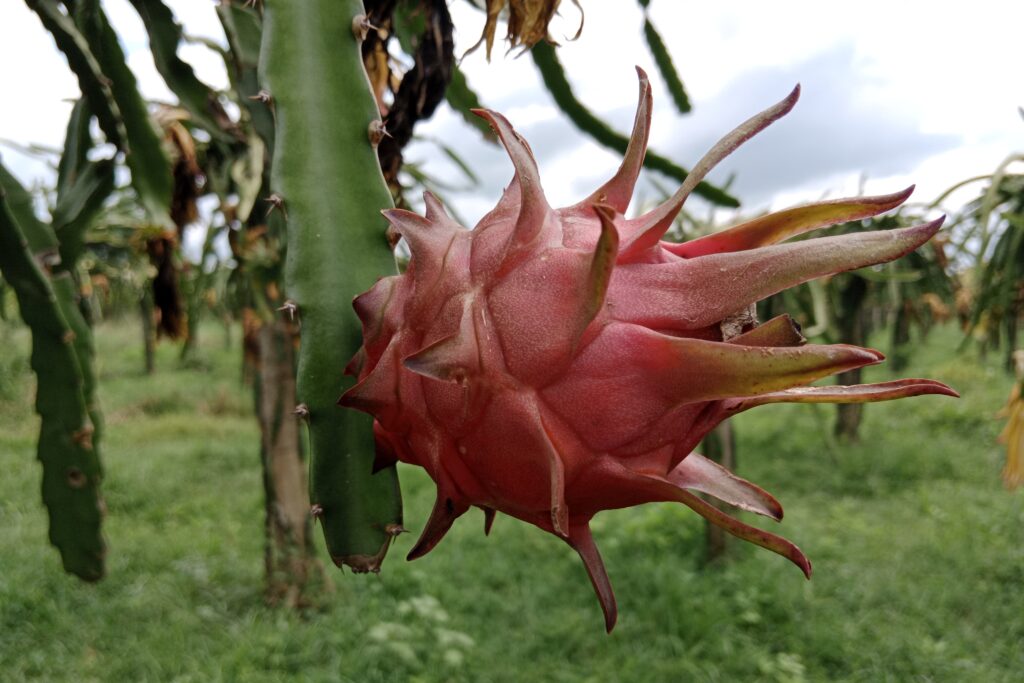Capsicum Farming
Capsicum farming profit per acre can be highly rewarding when managed effectively, as demonstrated by a detailed profit analysis. In this scenario, the gross income from one acre of capsicum cultivation amounts to NRs. 375,000, while the total investment cost stands at NRs. 151,000. This results in a substantial net profit of NRs. 224,000, showcasing the economic viability of the crop.

The profit margin is calculated at approximately 148.35%, indicating that for every rupee invested, the return is more than double the input cost. Similarly, the return on investment (ROI) also stands at 148.35%, reinforcing the fact that with proper agronomic practices, pest and disease management, and timely harvesting, capsicum farming can be a highly lucrative agricultural venture.
Land Preparation
Capsicum farming begins with thorough land preparation to ensure healthy plant growth and efficient irrigation. Deep plowing to a depth of 20–25 cm helps break hardpans and enhances soil structure, followed by 2–3 cross harrowings to create a fine, crumbly tilth.
The field is then carefully leveled to support uniform irrigation and proper drainage. Raised beds are prepared with a width of 90–120 cm to accommodate two rows of plants, a height of 20–30 cm to facilitate effective drainage, and furrows 45–60 cm wide for ease of walking and irrigation. Beds should be oriented north-south to maximize sunlight exposure throughout the day.
Soil solarization, though optional, is recommended—cover the prepared beds with clear polythene sheets for 4–6 weeks during the hottest period to eliminate soil-borne pests, pathogens, and weed seeds. Simultaneously, incorporate well-decomposed FYM or compost along with a portion of basal fertilizers into the top 15 cm of soil to enrich fertility before planting.
Soil Type
The ideal soil type is deep (minimum 30-45 cm), well-drained, sandy loam to loamy soil rich in organic matter, though well-drained clay loams are also suitable; the crop can tolerate a wider range than many others provided drainage is perfect. Regarding soil reaction, a slightly acidic to neutral pH (5.5 – 7.0) is required, with 6.0 – 6.8 being optimal; soils below pH 5.5 require lime application, while those above pH 7.5 can cause micronutrient deficiencies. Crucially, perfect drainage is absolutely non-negotiable, as waterlogged conditions quickly lead to root rot and plant death, making the use of raised beds essential.
Climatic Requirements
| Category | Requirement |
| Temperature | |
| · Optimal Day | 21°C – 27°C |
| · Optimal Night | 15°C – 18°C |
| · Germination | 20°C – 30°C (optimal ~25°C) |
| · Critical | Growth severely stunted below 15°C. Flowers/fruit drop below 15°C or above 32°C. Frost is fatal. |
| Rainfall | Prefers moderate rainfall (600 mm – 1200 mm), well-distributed. Heavy rain during flowering/fruiting promotes disease. Requires irrigation in dry climates/periods. |
| Humidity | Moderate (50% – 70%) ideal. Very high humidity (>80%) favors fungal/bacterial diseases. Low humidity causes plant stress. |
| Light | Requires full sunlight (6-8 hours daily) for optimal growth, flowering, and fruit development/coloration. Tolerates light shade (yield/quality reduced). |
Major Cultivars:
The selection of major pepper cultivars depends on market preferences (color, size, shape), climate suitability, disease resistance, and whether cultivation occurs in open fields or protected environments. Cultivars are primarily categorized into two growth types: determinate varieties, which are bushy with a defined growth period (e.g., Yolo Wonder and California Wonder, typically for open fields), and indeterminate varieties, which grow via a single apical stem with minimal branching (e.g., Commandant F1, Admiral F1, Nemalite F1, Green Bell F1, commonly used in greenhouses).
| Classification | Subcategory | Cultivars/Characteristics |
| General | – | Choice depends on market (color/size/shape), climate, disease resistance, and open field vs. protected cultivation. |
| By Color | Green | California Wonder, Yolo Wonder, Arka Mohini, Arka Gaurav, Bharat, Nishat-1 (most common for early harvest) |
| Yellow | Golden California Wonder, Orobelle (F1), Sun Bright | |
| Red | King of the North, Indra, Bomby (F1), Red Knight | |
| Orange | Orange Sun, Valencia | |
| Purple/Brown | Chocolate Beauty, Purple Beauty | |
| By Type | Blocky | Standard bell shape (California Wonder types) |
| Lamuyo | Long, blocky, thick-walled (common in Europe) | |
| Cherry/Mini | Small, round fruits (appetizer/salads) | |
| By Breeding | Hybrids | Dominant commercially: Higher yield, uniformity, disease resistance (e.g., Pusa Deepti, Bharat, Nunhems varieties, Syngenta varieties) |
| Open Pollinated (OPV) | California Wonder remains popular |
Seed Rate per Acre
The recommended seed rate for capsicum cultivation is approximately 150 grams per acre.
Nursery Management
Capsicum is usually raised in a nursery and later transplanted, although direct sowing is also an option. To enhance germination, seeds can be started in seed trays, using a seed rate of 150g per acre. The nursery should be located on well-drained soil that hasn’t been used for Solanaceae crops in the last three years to prevent disease buildup.
Beds should be 1 meter wide and of convenient length, with drills spaced 10–20 cm apart. Seeds are sown thinly, lightly covered with soil, watered regularly, and shaded with dry grass or organic material to protect the young seedlings from sun exposure. Whiteflies, which can transmit viruses, should be managed using insect-proof nets. A nursery area of 100–150 sq. meters is sufficient for raising seedlings for one acre, with plug trays (98–104 cells) preferred for uniform growth.
Transplanting is carried out when seedlings are 50–60 days old and have developed 4–5 true leaves. It is best done during the evening or on cloudy days to reduce transplant shock. Before uprooting, water the nursery beds thoroughly to ease seedling removal and reduce root damage. Seedlings are then transplanted into well-prepared main fields for further growth.
Planting
a). Planting Season
| Region/Method | Planting Season | Transplanting Time | Harvesting Period | Notes |
| Plains (Rabi) | Winter | September – November | December – March/April | Ideal season for open-field cultivation |
| Plains (Kharif) | Monsoon (Risky) | June – July | August – October | Disease risk due to monsoon conditions |
| Hills (Single Crop) | Summer | March – April | June – September | Suitable for hill regions |
| Hills (Two Crops) | Dual season | March – April & July – August | Varies accordingly | Two crop cycles possible |
| Protected Cultivation | Year-round (Controlled Env.) | Any time of year | Depends on planting time | Requires climate control setup |
b). Spacing
Capsicum should be spaced 60 cm between rows and 45 cm between plants, following a bed layout of two rows per bed with staggered planting to ensure optimal growth and airflow.
c). Planting Method
The primary planting technique is transplanting. Begin with robust seedlings, 4-6 weeks old, showing no signs of disease and featuring 4-6 developed true leaves along with a strong stem. Prior to transplanting, acclimate these seedlings through a 5-7 day hardening process, slowly introducing them to outdoor sun and wind exposure.
To lessen transplant shock, schedule the actual transplanting for late afternoon or during overcast conditions. When planting, position each seedling at precisely the same soil depth it occupied in the nursery container, ensuring the stem base remains uncovered. Essential watering steps include thoroughly soaking seedlings before lifting them from the nursery and irrigating the planting hole or row promptly after placing each seedling.
Concluding the process, it is highly advised to immediately apply a layer of mulch—either organic materials like straw or dried leaves, or silver-black plastic mulch—around the newly transplanted seedlings.
Low Tunnel Technology: This method is employed for achieving early capsicum production in early summer by providing crucial protection against cold weather, particularly during the critical period from December to mid-February.
The process involves preparing beds 2.5 meters wide and sowing the crop in December, utilizing specific spacing with 130 cm between rows and 30 cm between plants within a row. Before covering, support rods ranging from 45 to 60 cm in height are firmly fixed along the beds.
These rods then support a protective covering of 100-gauge plastic sheets, forming a low tunnel microclimate that shields the young capsicum plants from cold stress. As ambient temperatures begin to rise significantly around February, the plastic sheets are removed to prevent overheating and facilitate the plants’ adaptation to the seasonal transition, allowing for continued growth towards harvest.
d). Number of Plants per Acre
14,988 plants.
Intercropping
Due to capsicum’s dense canopy and relatively short growing duration, intercropping directly within the main capsicum plot is uncommon. However, during the initial 4-6 weeks after transplanting capsicum, it is possible to plant quick-maturing, low-growing, non-competitive crops like radish, lettuce, spinach, or onion between the beds; this requires careful management to avoid competing with the capsicum plants. More commonly, capsicum is integrated into sequential cropping or rotation systems alongside other crops such as legumes (beans, peas), crucifers (cabbage, cauliflower), or cereals.
Irrigation
Consistent moisture is crucial for capsicum, especially during flowering and fruit development, as water stress can lead to blossom drop and deformed fruits. Drip irrigation is highly recommended, offering efficient water and fertilizer use, reducing disease by keeping foliage dry, and allowing precise moisture control.
After transplanting, light and frequent irrigation (daily or alternate days) is needed for 7–10 days, followed by watering every 3–4 days during establishment. During flowering and fruiting, irrigate every 2–3 days or as needed to maintain even soil moisture, avoiding both drought and waterlogging. Overhead sprinklers and flooding should be avoided, and soil moisture should be regularly monitored using a finger test or tensiometer.
Fertilizer and Manure Recommendations for Capsicum (Per Acre Basis)
For precise fertilizer application in capsicum cultivation, conducting a soil test is strongly recommended. However, in the absence of a soil test, general fertilizer recommendations are provided below:
| Category | Type/Component | Details | Timing/Stage | Application Method |
| Organic Matter | FYM/Compost | 15-20 tonnes of well-decomposed material | During land preparation | Incorporate thoroughly into soil |
| Biofertilizers | Azospirillum | 1 kg | During planting | Soil application |
| PSB (Phosphate Solubilizing B.) | 1 kg | During planting | Soil application | |
| Potash Mobilizing Bacteria | 1 kg | During planting | Soil application | |
| Inorganic (Basal) | Total Basal Application | Full P & K + ⅓ N | At planting | Incorporate into beds |
| Nitrogen (N) | 50 kg (equivalent to Urea: 100 kg) | |||
| Phosphorus (P₂O₅) | 25 kg (equivalent to SSP: 175 kg) | |||
| Potassium (K₂O) | 12 kg (equivalent to MOP: 20 kg) | |||
| Inorganic (Top Dress) | Nitrogen (N) | ⅓ of total N | 30-35 days after transplanting | Apply near root zone; avoid stems. Water immediately. |
| Nitrogen (N) | ⅓ of total N | 55-60 days after transplanting OR at first fruit set | Fertigation via drip is highly efficient | |
| Micronutrients (Foliar) | Calcium Nitrate | 0.5% solution | As needed | Foliar spray (Prevents Blossom End Rot) |
| Magnesium Sulphate | 0.5% solution | As needed | Foliar spray (Promotes green foliage) | |
| Boron | 0.2-0.3% solution | As needed | Foliar spray (Aids fruit set/development) | |
| Zinc Sulphate | 0.3-0.5% solution | As needed | Foliar spray |
Weed Control
Effective weed suppression is critical, particularly in the crop’s initial growth phase, due to intense competition for nutrients and water. Mulching stands as the optimal strategy: silver-black plastic mulch effectively controls weeds while simultaneously conserving soil moisture, moderating soil temperature, and enhancing light reflection; alternatively, a 5–8 cm layer of organic mulch also provides satisfactory weed suppression.
Where mulching is not employed, careful manual weeding around plants is essential to prevent root injury. Shallow tillage between beds may supplement control in unmulched areas. Herbicides require judicious application exclusively before planting: apply non-selective glyphosate during field preparation, and use pendimethalin (e.g., Stomp 30% EC at 3.3 L/acre) 1–2 days prior to transplanting to manage grassy and certain broadleaf weeds—never apply herbicides after transplanting.
Adhere strictly to a timely weeding schedule: conduct the first weeding 30 days after transplanting and the second at 60 days. Additionally, earthing up plants 2–3 weeks post-transplant aids in removing weeds effectively.
Flowering and Fruit Management
Flowering in capsicum begins about 4–6 weeks after transplanting, with the crop being primarily self-pollinating, though bees and flies can enhance fruit set—hence, insecticide use during flowering should be avoided. Successful fruit set requires optimal temperatures between 20–27°C, as extreme heat or cold can lead to blossom drop, while consistent watering and adequate potassium are essential.
Fruits typically mature 55–80 days after transplanting, depending on the variety and season, with maturity marked by a change in color from green to yellow, orange, red, or purple. In high-density or protected cultivation, practices like topping (removing the growing tip after 4–5 branches), suckering (removing shoots from leaf axils below the first fork), and staking (using stakes or trellises to support tall plants) can improve air circulation, reduce disease risk, and enhance fruit quality and yield.
Pest and Disease Management
Common Pests
a). Thrips
Thrips infestation in capsicum is identified by white blotches on the leaves and stunted plant growth. Effective control measures include spraying Malathion (Cythion 50 EC) at 1.5 ml per liter of water or Dimethoate (Rogor 30 EC) at 2 ml per liter. Additionally, thrips can be managed by spraying Nicotine sulphate at a concentration of 0.25%.
b). Aphids
Aphids damage capsicum plants by feeding on the cell sap of leaves, leading to weakened growth and potential disease transmission. Effective control involves spraying Monocrotophos at 0.05–0.01% or Demeton methyl at 0.05–0.02% concentrations to eliminate the pest and protect the crop.
c). Fruit Borer (Helicoverpa armigera)
Fruit borer (Helicoverpa armigera) is a major pest in capsicum that bores into developing fruits, causing direct damage and yield loss. Effective control measures include spraying insecticides Chlorantraniliprole at 4 kg per acre. Additionally, installing pheromone traps and regularly removing and destroying infested fruits help reduce pest population and prevent further spread.
d). Whiteflies
Whiteflies (d): These pests damage capsicum plants by sucking sap, weakening growth, and transmitting harmful viruses (like leaf curl and mosaic viruses), while their honeydew secretions promote unsightly sooty mold growth on leaves and fruit. Effective control requires an integrated approach: Chemical treatments include foliar sprays of Buprofezin (25% SC @ 0.5–1 ml/L water), Pyriproxyfen (10% EC @ 0.5–1 ml/L), or Imidacloprid (17.8% SL @ 0.3–0.5 ml/L) applied at early infestation signs, with rotation to prevent resistance.
Physical control employs yellow sticky traps (4–6 traps/acre) placed just above the canopy to attract and capture adults. Cultural practices like removing weed hosts, using reflective mulch, and ensuring field sanitation reduce breeding sites. For severe infestations, combine targeted spraying (underside of leaves) with trap monitoring and neem oil (2–3 ml/L) as an organic supplement. Timely intervention during warm, dry periods—when whiteflies proliferate—is critical to prevent yield loss.
e). Mites
Mites are tiny, spider-like pests that attack capsicum plants by feeding primarily on the undersides of leaves, resulting in yellowing, speckling, leaf curling, and a noticeable decline in plant health and yield. In severe cases, they can cause defoliation, disrupt photosynthesis, and lead to major crop losses. These pests favor warm, dry climates and often remain undetected until significant damage occurs.
To control mite infestations effectively, Cypermethrin 5 EC can be applied at 3 ml per liter of water. Alternatively, Dimethoate (Rogor) at 2 ml per liter or Dicofol (Kelthane) at 1.5 ml per liter also provides effective management. Regular scouting and prompt treatment are essential to keep infestations under control.
Common Diseases
a). Damping Off
Damping off is a fungal infection affecting young seedlings, characterized by the appearance of patches on the stem that soon wither and cause the seedlings to die. The disease can spread swiftly, often impacting the entire crop within 4 to 5 days. It commonly develops in poorly drained soils where excess moisture encourages fungal growth. Effective control measures include spraying a Bordeaux mixture at 0.5–1.0% concentration or applying copper oxychloride fungicides such as Blitox or Fytolan to protect the seedlings and reduce the spread of the disease.
b). Bacterial Wilt
Bacterial wilt is characterized by the quick wilting of leaves and fruits, significantly impacting the health and productivity of capsicum plants. Preventive measures include applying 15 kg of bleaching powder prior to planting and cultivating resistant varieties to minimize infection risks and enhance the crop’s ability to withstand the disease.
c). Phytophthora Blight
Phytophthora blight is a serious disease in capsicum characterized by symptoms such as wilting of plants, dark lesions on stems, and fruit rot, which can cause significant yield losses if not managed properly. The disease thrives in wet and poorly drained soils, making proper water management essential for control.
Implementing perfect drainage and using raised beds can help reduce moisture accumulation around the roots, limiting the spread of the pathogen. Avoiding overhead irrigation is also important to prevent water splashing that spreads the disease. Crop rotation with non-host plants further helps break the disease cycle.
Chemical control using fungicides like Metalaxyl, Fosetyl-Al, or Potassium phosphonate applied as soil drenches or prophylactic sprays provides effective management of Phytophthora blight and helps protect the crop from severe damage.
d). Powdery Mildew
Capsicum plants are vulnerable to powdery mildew, a significant fungal disease prevalent in warm summer weather. The telltale white, powdery growth on leaves (and potentially stems/fruit) disrupts photosynthesis. Consequently, plants become stunted, weak, lose leaves early, and produce lower yields of poorer quality. Since the fungus flourishes in warm humidity, proactive management is critical. This involves spraying fungicides such as Sulfex or Tridemorph (0.2% solution) every two weeks to combat spores, alongside preventative measures like proper spacing and ventilation to discourage fungal development.
e). Anthracnose (Colletotrichum spp.)
Anthracnose is a fungal disease that affects stems, leaves, and fruits, characterized by dark, round spots on fruits and tiny black spots on seeds, often causing infected fruits to drop prematurely; it thrives in high humidity. Management involves mandatory preventative seed treatment before sowing using Thiram (0.2%) or Brassico (0.2%), and if infection occurs, curative sprays of Dithane M-45 (0.4%), Blitox (0.4%), or Difoltan (0.2%) applied every 15 days.
f). Leaf Curl disease
Leaf curl disease in capsicum is characterized by symptoms including leaf curling, blistering between veins, and thickening of the leaf mid-vein; to prevent disease spread, infected plants must be promptly removed and destroyed.
Harvesting
Capsicum plants generally reach maturity 2 to 3 months after transplanting, and the fruits can be harvested either at the harvestable-green stage or after they have fully developed their characteristic color, depending on the desired market preference and variety.

Capsicum harvesting should be timed according to the desired fruit stage. For green capsicum, fruits are harvested when they reach full size, are firm, have thick walls, and display a deep green color before any color change begins—this is the most common harvest stage.
Colored varieties such as red, yellow, or orange should be picked only after they fully develop their characteristic color, which requires leaving them on the plant longer. During the peak season, harvesting should be done every 3–5 days, handling fruits carefully to avoid bruising.
Harvesting is best done manually using sharp secateurs or knives, leaving a 0.5–1 cm stem on the fruit; pulling by hand should be avoided. It is advisable to harvest during the cooler parts of the day. After harvest, fruits should be sorted by size, color, and quality, quickly pre-cooled, and packed in ventilated crates or cartons. Green peppers are best stored at 7–10°C with 90–95% relative humidity, while colored peppers should be stored slightly warmer (7–13°C) to prevent chilling injury.
Yield
In open field cultivation, F1 hybrid capsicum yields typically range from 10,000 to 20,000 kg per acre for green fruits, while colored varieties generally produce slightly lower yields due to longer maturity periods and increased sensitivity to environmental conditions.
Cost of Investment Per Acre for Capsicum Farming
| S.N. | Category | Cost (NRs) |
| 1 | Land Preparation (plowing) | 15,000 |
| 2 | Seed cost | 5,000 |
| 3 | Nursery management | 5,000 |
| 4 | Transplanting | 7,000 |
| 5 | Mulching | 10,000 |
| 6 | Fertilizers and Manure | 10,000 |
| 7 | Irrigation (Drip) | 75,000 |
| 8 | Weed Control (pre/post-emergence) | 4,000 |
| 9 | Pest & Disease Control | 6,000 |
| 10 | Harvesting | 4,000 |
| 11 | Miscellaneous Costs | 10,000 |
| Total Cost | 151,000 |
Income from per acre capsicum farming
| Particular | Estimated Yield (kg) | Market Price (NRs/kg) | Total Income (NRs) |
| Capsicum Yield | 15,000 | 25 | 375,000 |
Analysis of Capsicum Farming Profit Per Acre
The profit analysis for capsicum cultivation shows a gross income of NRs. 375,000 against a total investment cost of NRs. 151,000, resulting in a net profit of NRs. 224,000. This yields a profit margin of approximately 148.35%. The return on investment (ROI) is also 148.35%, indicating a highly profitable venture under proper management.
Capsicum Farming Crop Calendar (Plains – Rabi Season)
| Month | Key Activities | Additional Notes |
| June-July | · Land preparation: Deep plowing (20-25 cm), harrowing, leveling. · Bed preparation: Raised beds (90-120 cm width, 20-30 cm height). · Soil solarization (4-6 weeks under clear polythene). · Basal fertilizer & FYM incorporation (15-20 tonnes/acre). | Avoid Solanaceae crops in previous 3 years. Ideal bed orientation: North-South. |
| August | · Nursery establishment: Sow seeds (150g/acre) in trays/beds. · Shade management: Protect seedlings with nets/dry grass. · Whitefly control: Insect-proof nets in nursery. | Nursery area: 100-150 sqm/acre. Use plug trays for uniform growth. |
| September | · Transplanting (50-60-day-old seedlings; 4-5 true leaves). · Spacing: 60 cm between rows, 45 cm between plants (14,988 plants/acre). · Irrigation: Light daily watering post-transplant. · Mulching: Apply silver-black plastic/organic mulch. | Transplant on cloudy days/evenings to reduce shock. |
| October | · First top-dressing: ⅓ N (17 kg Urea/acre) at 30-35 DAT*. · First weeding (30 DAT). · Drip irrigation: Every 3-4 days. · Pest monitoring: Aphids, thrips. | *DAT = Days After Transplanting. Avoid overhead irrigation. |
| November | · Flowering begins (4-6 weeks after transplanting). · Second top-dressing: ⅓ N (17 kg Urea/acre) at 55-60 DAT. · Second weeding (60 DAT). · Micronutrient sprays: Calcium/Boron (if needed). | Maintain optimal temps (21-27°C day). Avoid insecticides during flowering. |
| December | · Fruit development phase. · Low tunnel removal (if used for early crop). · Staking: Support plants. · Disease control: Monitor for powdery mildew, anthracnose. | Increase irrigation frequency (every 2-3 days). |
| January | · Harvesting begins (green stage, 70-80 DAT). · Pest control: Fruit borer, mites (spray Chlorantraniliprole/Cypermethrin if needed). · Regular picking: Every 3-5 days. | Harvest with secateurs; leave 0.5-1 cm stem. |
| February | · Peak harvesting (green & colored capsicums). · Post-harvest: Sorting, pre-cooling (7-10°C for green). · Colored capsicum harvest (if left to ripen). | Colored varieties stored at 7-13°C. |
| March-April | · Final harvest. · Field cleanup: Remove plant debris. · Soil health: Plan crop rotation (legumes/cereals). | Yields: 10,000-20,000 kg/acre (green), lower |
Sources
Food and Agriculture Organization (FAO)
Indian Council of Agricultural Research (ICAR)
JICA- Capsicum production
Nepal Agricultural Research Council
Tamil Nadu Agriculture University- Agritech portal
Punjab Agriculture University (PU)



